Wai-Fah Chen.The Civil Engineering Handbook
Подождите немного. Документ загружается.

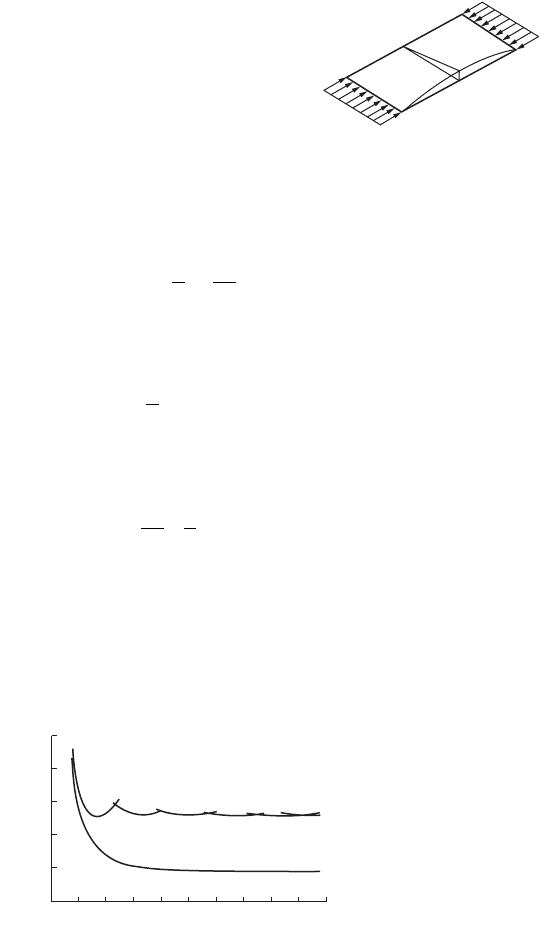
49-14 The Civil Engineering Handbook, Second Edition
the element. Using this stress together with the critical stress, based on a K factor of 4, the effective width
may be found as it is for uniformly compressed elements. The effective portions of the element are
considered to be equally distributed adjacent to each supported edge, as for uniformly compressed
elements, and the ultimate load on the element may be assumed to occur when the maximum stress
reaches yield. This rather rough-and-ready method has some theoretical backing and gives reasonable
and conservative results when compared with tests.
Unstiffened Elements
In open sections there are normally unstiffened elements. As these
elements buckle much more quickly than stiffened elements, they
constitute a rather unsatisfactory type of element with regard to
load capacity, and because of this the cold-formed counterparts of
common hot-rolled sections such as channels, angles, and hat sec-
tions are often lipped to increase the resistance to local buckling.
Unstiffened elements can also be analyzed using the approach
employed earlier for stiffened elements. If we assume that the out-
of-plane deflections of an unstiffened element under load, as shown
in Fig. 49.14, are given by the expression
(49.16)
then the same type of analysis gives the following results
(49.17)
and the relative stiffness before and after buckling is
(49.18)
The variation of K with the variation in the element length-to-width ratio is shown in Fig. 49.15. In
this case the element buckles into a single half wavelength, regardless of its length, according to the
analysis used. This is only true in cases where the supported edge is simply supported, such as elements
of angle sections. For unstiffened elements that have some restraint on their supported edge a number
of buckles are found if the element is long. However, the simply supported free condition gives a lower
FIGURE 49.15 Variation of buckling coefficients for unstiffened elements with element length.
FIGURE 49.14 Unstiffened element
under compression.
Supported edge
Free edge
ww
y
b
x
a
=
max
sin
p
K
b
a
=
Ê
Ë
Á
ˆ
¯
˜
+
2
0 425.
E
E
*
=
4
9
n = 1
23
4
65
K
2.5
2.0
1.5
1.0
0.5
012345678910
l/b
© 2003 by CRC Press LLC
Cold Formed Steel Structures 49-15
bound to the strength and stiffness of more restrained elements and leads to safe design. The buckling
coefficients applicable to a fully fixed supported edge are also shown in Fig. 49.15 for comparison
purposes.
The minimum value of K in this case is 0.425 for an element with simple support on the supported
edge, based on a Poisson’s ratio of 0.3. Thus the buckling load of an unstiffened element is reduced by
a factor of 4/0.425, i.e., 9.4, from that of a stiffened element.
Effective Widths
Returning to our approximate analysis, if we examine the load compression behavior of a perfect plate
after buckling and plot the relevant curves for stiffened and unstiffened elements, normalized with respect
to the buckling point, we find that the postbuckling stiffness of the unstiffened element is greater than
that of a stiffened element at a given multiple of the buckling stress. Because the effective width expressions
contain the critical stress, it follows that the same expression will be rather conservative for unstiffened
elements.
In the British code the effective widths so obtained are increased for unstiffened elements. The method
used is to initially determine the effective width, b
eff
, as for a stiffened element, but using the buckling
coefficient applicable to the unstiffened element under examination. This is then converted to an
enhanced effective width for an unstiffened element using the following equation:
b
eu
= 0.89b
eff
+ 0.11b (49.19)
Stiffeners
Edge Stiffeners
Because of the low buckling resistance of unstiffened elements and the rather unfortunate consequences
that can arise, the benefits of incorporating edge stiffeners are plain to see. Adequately edge-stiffened
elements can be substantially stronger than the unstiffened counterparts. In general an edge stiffener is
required to eliminate, or at least minimize, any tendency for the otherwise unsupported edge of an
element to displace out of plane. If a stiffener is adequate, the stiffened element will not incur deflections
at the stiffened edge, and the element can be treated as a stiffened element. If, however, the stiffener does
not have sufficient flexural rigidity to prevent out-of-plane deflections of the edge, the stiffener is said
to be inadequate.
The precise requirements for adequacy are even now undergoing change. In various cold-formed steel
design codes in the past it was accepted that for adequacy, a stiffener should prevent buckling of the
element edge until the element buckled as a stiffened plate with a K factor of 4. This was shown (Desmond
et al., 1981) to be an insufficient requirement, as the edge stiffener must also be able to prevent the edge
of the element from buckling even after local buckling has occurred, indeed until it fails as a stiffened
element if it is to do its job correctly. The requirements for adequacy in the latest AISI code and in the
European recommendations have been based on this premise.
However, this is not the only difficulty in assessing stiffener adequacy. Rigorous analysis shows that
the required rigidity of an edge stiffener depends not only on the geometry of the element to be stiffened,
but on the geometry of the section as a whole and indeed on the geometry of the stiffener itself (Rhodes,
1983). Thus obtaining a single formula that covers all these variables with accuracy is a daunting task.
Intermediate Stiffeners
Intermediate stiffeners are becoming more widely used in cold-formed steel members. The advantages
of replacing slender elements by more effective subelements of relatively compact proportions at the
expense of a little extra material for the stiffener are apparent. As with edge stiffeners, the intermediate
stiffeners used must have adequate rigidity to prevent deflection in the element in the region of the
stiffener. Adequate and inadequate stiffeners of this type are illustrated in Fig. 49.16. The geometry of
an element with a single intermediate stiffener is shown in Fig. 49.17a.
© 2003 by CRC Press LLC
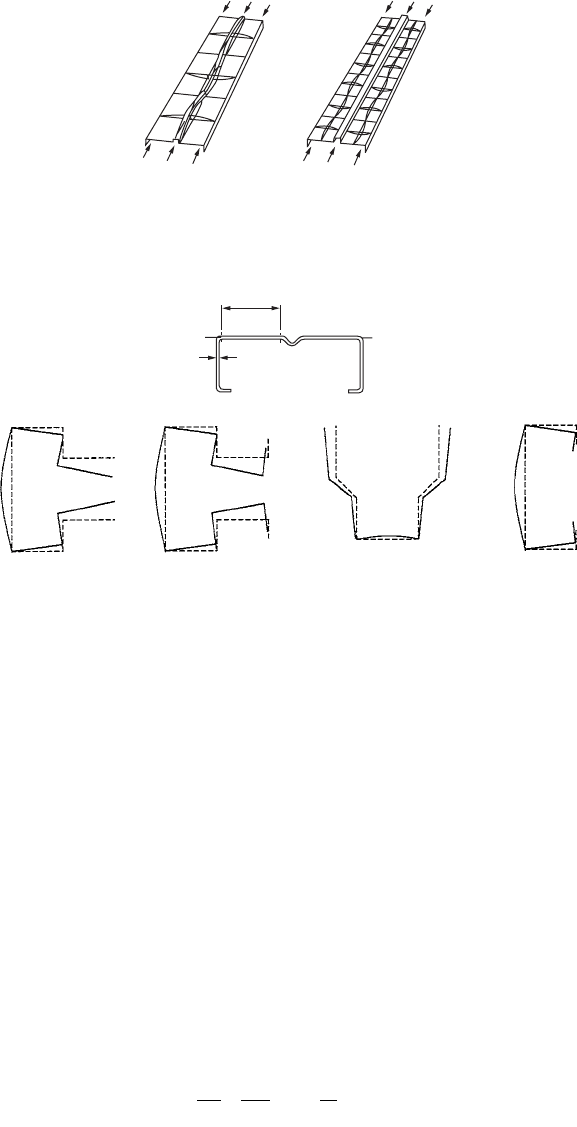
49-16 The Civil Engineering Handbook, Second Edition
If the rigidity requirement is attained by an intermediate stiffener, the effective area of the stiffened
element may, under certain conditions, be evaluated from the sum of the effective areas of each individual
subelement, analyzed as stiffened elements, and the stiffener area. The condition under which this is
allowable is that the width-to-thickness ratios of the subelements are less than 60. Since in this case the
out-of-plane deflections are eliminated near the stiffener, the hypothetical situation is that under uniform
compression here, there is no shedding of load near the stiffener and this area of the element becomes
fully stressed. Each subelement is therefore stressed in the same manner as a stiffened element of width
w. The stiffener is also fully stressed and plays its full part in resisting the load.
Reductions in Capacity for High Width-to-Thickness Ratios
If the subelement width-to-thickness ratios are greater than 60, reductions in the subelement effective area
and in the effective stiffener area must be introduced. The main reasons for this are to be found in the
examination of beam behavior. Beams that have very wide, slender flanges, either in tension or compres-
sion, suffer from the tendency of these flanges more toward the neutral axis of the section under loading.
BS 5950, Part 5, takes the adverse effects into account in a rather simple way, based on the AISI
specification prior to the current version. If the subelement width-to-thickness ratio, w/t, is greater than
60, the effective width of the subelement, b
eff
, is replaced by a reduced effective width, b
cr
, determined
from the expression
(49.20)
The effective stiffener area is also reduced. For w/t less than 60, the stiffener is taken as fully effective.
For w/t greater than 90, the ratio of effective stiffener area, A
eff
, to full stiffener area, A
st
, is taken as the
same as that of the ratio of the effective subelement area to the full subelement area, i.e.,
FIGURE 49.16 Intermediate stiffeners: (a) inadequate stiffeners, (b) adequate stiffeners.
FIGURE 49.17 (a) Geometry of an element with a single intermediate stiffener. (b) Examples of distortional
buckling.
(a)
(b)
w
00
t
b
t
b
t
w
t
cr eff
=- -
Ê
Ë
Á
ˆ
¯
˜
01 60.
© 2003 by CRC Press LLC

Cold Formed Steel Structures 49-17
(49.21)
For w/t values between 60 and 90 a linear interpolation formula is used to obtain the effective stiffener
area. This is
(49.22)
This expression gives the stiffener effective area varying linearly from A
st
at w/t = 60 to A
st
b
cr
/w at w/t = 90.
Multiple Intermediate Stiffeners
If an element has many intermediate stiffeners that are spaced closely enough to eliminate significant
local buckling, i.e., w/t is less than 30, then all stiffeners may be considered effective. However, in such
a case local buckling that involves the complete element, with all stiffeners participating in the buckling,
has to be guarded against. This is accomplished in a rather simple way by considering the complete
element as a stiffened element without intermediate stiffeners, but having a fictitious equivalent thickness.
The fictitious thickness is arranged so that the flexural rigidity of the stiffened element is the same as
that of the multiply stiffened element. To accomplish this, the equivalent thickness, t
s
, is taken as
where I
s
= the second moment of area of the full multiply stiffened element, including the interme-
diate stiffeners, about its own neutral axis
w
s
= the complete width of the element between two webs
Distorsional Buckling
If a lip or edge stiffener, or indeed an intermediate stiffener, is not adequate, then the buckling mode
that arises involves in-plane movement of the stiffener together with out-of-plane distorsion of the
stiffened elements. Hancock (1988) observed that this kind of behavior was evident in some storage
racking members in which the edge stiffeners were not so clearly identifiable as lips and coined the term
“distorsional buckling” to cover this type of behavior. The term is now widely used to describe such
behavior, and at the same time the design treatment of stiffeners has been the subject of substantial
change in some recent specifications. Distortional buckling, as illustrated in Eurocode 3, Part 1.3, is
shown in Fig. 49.17b for some cross-sections. In Eurocode 3, Part 1.3, distortional buckling is specified
as a design consideration that must be taken into account. For edge and intermediate stiffeners recourse
can be made to the relevant rules for these elements, which are extremely demanding in calculation time
and which result in significant diminution of the potential capacity of a stiffened element. Indeed, in the
design of Z- or C-section beams to Eurocode 3, Part 1.3, the capacity is very substantially governed by
the edge stiffener.
Example 49.1
Compute the effective width of the compression (top) flange of the beam shown in Fig. 49.18; assume
that the compressive stress in the flange is 25 ksi. E = 29,500 ksi and n = 0.3.
FIGURE 49.18 Example 49.1.
AA
b
w
eff st
cr
=
AA
b
w
b
w
w
t
eff st
cr cr
=-+-
Ê
Ë
Á
ˆ
¯
˜
Ê
Ë
Á
ˆ
¯
˜
32
1
30
1
t
I
w
s
s
s
=
Ê
Ë
Á
ˆ
¯
˜
12
13
x
20"
x
10"
1.34"1.34"
0.105"
R = 3/16"
© 2003 by CRC Press LLC
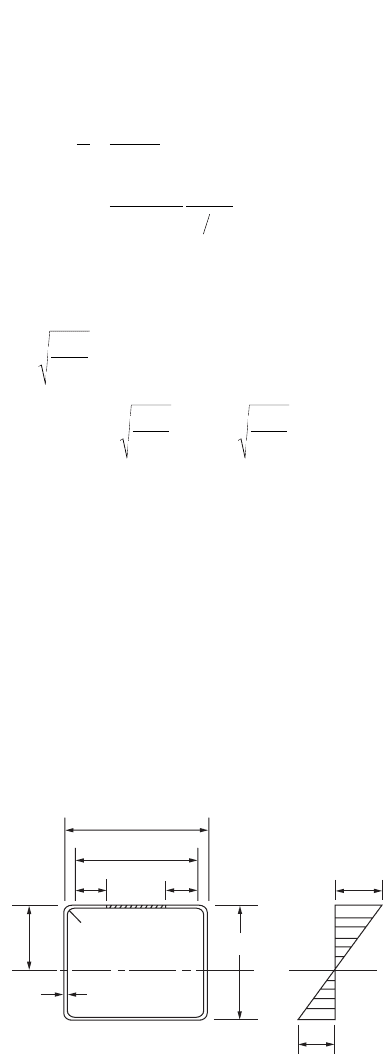
49-18 The Civil Engineering Handbook, Second Edition
Solution:
The following solution is based on the AISI design code:
As the first step, compute p
max
/p
cr
.
\
Example 49.2
Calculate the effective width of the compression flange of the box section (Fig. 49.19) to be used as a
beam bending about the x axis. Use p
max
= 33 ksi. Assume that the beam webs are fully effective and that
the bending moment is based on initiation of yielding. E = 29,500 ksi and n = 0.3.
Solution:
The solution is in accordance with the AISI code.
Because the compression flange of the given section is a uniformly compressed stiffened element,
which is supported by a web on each longitudinal edge, the effective width of the flange can be computed
by using Eq. (49.14) with K = 4.0.
FIGURE 49.19 Example 49.2.
K
bRt
in
b
t
p
E
bt
ksi
p ksi
p
p
bb
p
p
p
p
cr
cr
eff
cr cr
=
=- +
()
=- +
()
=
==
=
-
()
()
=
=
=>
=-
È
Î
Í
Í
˘
˚
˙
˙
=
40
20 2
20 2 0 1875 0 105 19 415
19 415
0 105
184 9
4
12 1
1
312
25
283 0673
1022
2
2
2
.
.. ..
.
.
.
.
..
.
max
max
max max
p
n
66 518..in
6.50"
w = 6.19
b/2 b/2
F
y
<F
y
x
6.00"
t = 0.06"
R = 3/32"
x
y
_
© 2003 by CRC Press LLC
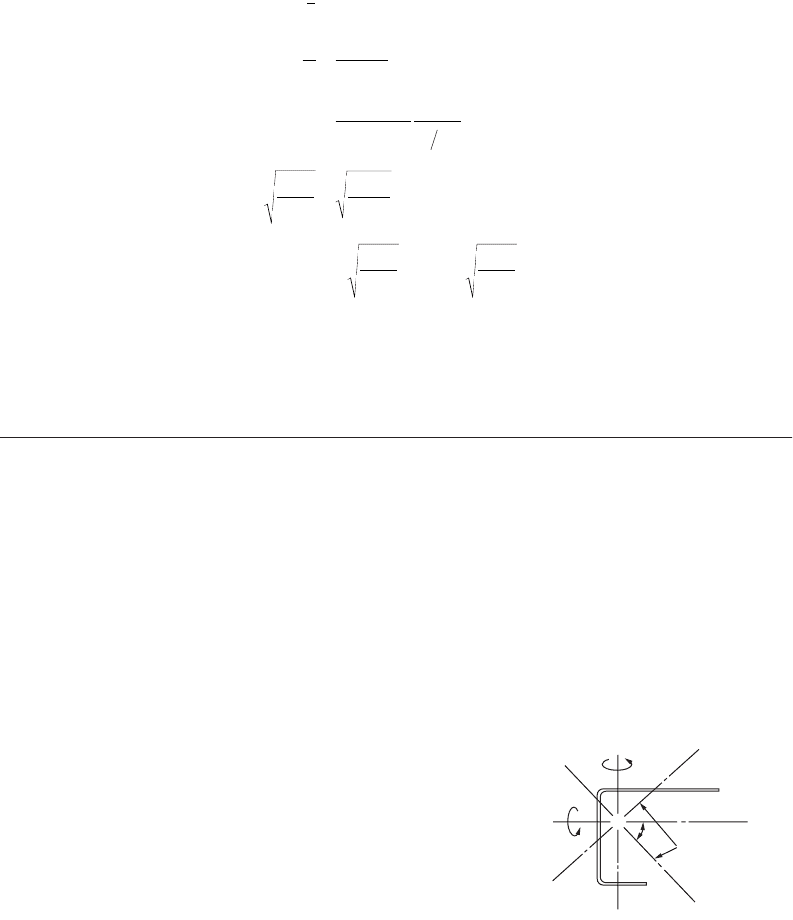
Cold Formed Steel Structures 49-19
Given that the bending strength of the section is based on initiation of yielding
\
49.3 Members Subject to Bending
Because of the thin-walled nature of cold-formed steel sections, the effects of local buckling must, in
most cases, be taken into account in determining the moment capacity and flexibility of beams. In the
design of beam webs, the capacity of webs to withstand concentrated loads or support reactions must
be ensured and the interaction of different effects must be taken into account. In the case of unbraced
beams, the possibility of lateral torsional buckling arises, and the designer must be able to guard against
this phenomenon. There are certain circumstances when the use of the simple bending theory cannot
give realistic estimates of beam behavior. The most obvious of these circumstances arises in the design
analysis of beams having unsymmetrical cross-sections. If such beams are not restrained continuously
along their lengths, they must be analyzed taking into account the unsymmetrical nature of the behavior.
Bending of Unsymmetrical Cross Sections
Consider a thin-walled beam having a general nonsymmetrical
cross-section, as shown in Fig. 49.20. If the x-x and y-y axes
shown in the figure are not the principal axes of the cross-
section, the application of a moment about either one of the
axes will cause the beam to bend about both axes, i.e., a moment
M applied about axis x-x will cause bending about both the x-
x and y-y axes. There are several approaches to take account of
this behavior, one of these being the use of effective moments,
M
x
*
and M
y
*
.In this method the stresses and deflections occur-
ring in the beam under the action of moments are dealt with
as though x-x and y-y were principal axes, but with the actual
moments about these axes replaced by the effective moment
(Megson, 1975).
Laterally Stable Beams
A laterally stable beam is a beam that has no tendency to displace in a direction perpendicular to the
direction of loading. A beam may be laterally stable by virtue of its shape, or a beam may be considered
yin
b
t
p
E
bt
ksi
p
p
bb
p
p
p
p
in
in
cr
cr
eff
cr cr
= ≥
==
=
-
()
()
=
==>
=-
È
Î
Í
Í
˘
˚
˙
˙
=
ª
3
6 1924
006
103 21
4
12 1
1
10 01
33
10 01
1 816 0 673
1022
2 997
3
2
2
2
.
.
.
.
.
.
..
.
..
.
max
max max
p
n
FIGURE 49.20 Beam of unsymmetrical
cross-section.
*
ψ
Principal axes
x
U
y
y
V
V
x
U
M
y
M
x
© 2003 by CRC Press LLC
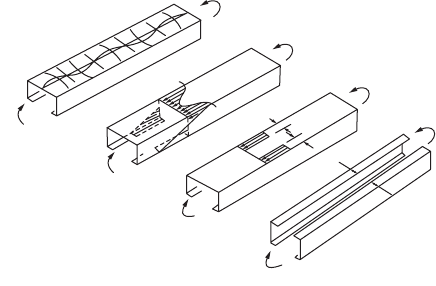
49-20 The Civil Engineering Handbook, Second Edition
laterally stable if it is braced sufficiently to prevent potential displacements out of the plane of loading.
For laterally stable beams local buckling is the major weakening effect. In the analysis of laterally stable
beams according to BS 5950, Part 5, limiting web stress is used to take into account the possibility of
local buckling in the webs and the effective width approach is used to take account of local buckling in
the compression elements.
Limiting Web Stress
The effects of local buckling due to varying bending stresses in thin webs of beams can be quite substantial.
The buckling stress in a web is generally much greater than in a compression element of the same
geometry, but if the web depth-to-thickness ratio is large, local buckling of the web can still have a
significant influence on the beam strength. For webs under pure bending the minimum buckling coef-
ficient is approximately 23.9, compared with 4 for a uniformly compressed plate.
The effects of local buckling on web strength are not so easily taken into consideration, as in the case
of elements under uniform compression. Effective width approaches have been investigated to take local
buckling of webs into account and have been found to accomplish this task very well, but at the expense
of adding further complexity to the analysis. This is mainly due to the necessity to position the effective
and ineffective portions correctly. A number of design codes, including the AISI code, use the effective
width approach. If a web has intermediate stiffeners, they will assist the web in resisting local buckling.
There has been substantial research into this topic.
Effective Width of Compression Elements
In the case of beams the elements under compression are considered to have effective widths less than
their actual widths, while all other elements are considered to have their actual dimensions. A typical
effective cross section is shown in Fig. 49.21. The effective width of the compression element or elements
is evaluated using effective width expression. For such elements the buckling coefficients in the case of
beams are in most circumstances greater than the minimum values, since buckling of the compression
elements is generally (but not always) restrained by the adjacent webs.
Moment Capacity
The moment capacity of the cross-section is determined on the basis that the maximum compressive
stress on the section is p
0
. This leads to two possible types of failure analysis, depending on the situation
on the tension side of the cross-section, as indicated in Fig. 49.22. If the geometry of the effective cross-
section is such that the compressive stress reaches p
0
before the maximum tensile stress reaches the yield
FIGURE 49.21 Effective width concept applied to laterally stable beams: (a) local buckles, (b) stress distribution,
(c) idealized stress distribution on compressive element, (d) effective section.
(a)
(b)
(c)
(d)
σ
σ
σ
σ
© 2003 by CRC Press LLC
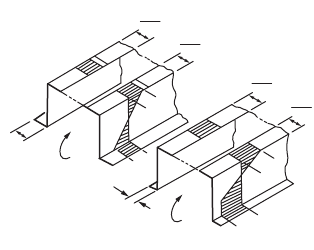
Cold Formed Steel Structures 49-21
stress, as in Fig. 49.22a, then the moment capacity is evaluated using the product of compression section
modulus and p
0
, i.e.,
M
c
= p
0
¥ Z
c
(49.23)
where Z
c
is the compression section modulus of the effective cross-section. This situation will occur in
the case of members that have wide tension elements or substantially ineffective compression elements.
If, on the other hand, the tensile stresses reach yield before p
0
is attained on the compression side, as
in Fig. 49.22b, the designer is allowed to take advantage of the plastic redistribution of tension stresses
and thus obtain higher predictions of moment capacity than would be the case if the first yield were
taken as the criterion. This necessitates an increase in the complexity of the analysis if the added capacity
is to be obtained. If simplicity of analysis is more important than the requirement to obtain the most
beneficial estimate of capacity, then the moment capacity can also be obtained using the product of the
yield stress and tension modulus of the effective cross section. This may well, however, lead to significant
underestimates of the member capacity.
Determination of Deflections
Determination of deflections is often required to satisfy deflection limitations at the working load, and
in such a case the use of the fully reduced properties will often give overconservative results. This occurs
because the effective section properties reduce progressively, and for thin-walled cross-sections these will
be greater at the working load than at the ultimate load. In general the use of the fully reduced section
properties overestimates deflections at loads below ultimate, whereas the use of the full section properties
underestimates these deflections.
Plastic Bending Capacity
The potentiality of local buckling and its adverse effects is not always present for cold-formed steel
sections. Since material thicknesses of up to 8 mm are covered primarily by codes and greater thicknesses
are not precluded, it is possible to have very compact cross-sections, even in the case of large members,
in which local buckling does not take place. In such cases the potential for fully plastic design cannot be
ignored. Local buckling is the major source of impairment of the capacity of a laterally stable member
to function adequately in the plastic range, and when this phenomenon is eliminated by virtue of the
compactness of the cross-section, the member can behave plastically.
For compact elements the cross-section not only can withstand the fully plastic moment, but also can
provide sufficient rotation capacity at the point of maximum moment to allow plastic redistribution of
the moments in statically indeterminate beams. The limiting width-to-thickness ratios for compression
elements of the plastic cross-section are specified in codes. Sections whose compression elements have
FIGURE 49.22 Failure criteria for laterally stable beams: (a) failure by compression yield — tensile stress elastic,
(b) tensile stresses reach yield before failure — elastic-plastic stress distribution.
(a)
(b)
b
l
b
l
Y
s
Y
s
Y
s
P
o
0
0
0
0
b
eff
2
b
eff
2
b
eff
2
b
eff
2
© 2003 by CRC Press LLC
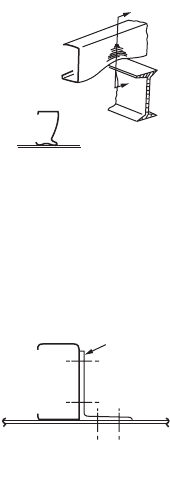
49-22 The Civil Engineering Handbook, Second Edition
b/t ratios less than the limiting values may be designed using the principle of plastic analysis, providing
that the following qualifying features are complied with:
1. The member is laterally stable.
2. The virgin yield strength of the material is used, and the enhanced yield due to cold-forming
effects is neglected.
3. The depth-to-thickness ratio of the compression portion of the web is less than the value specified
in the codes.
4. The maximum shear force is less than the value limited by the code.
5. The angle between any web and the loading plane does not exceed 20°.
6. The ratio of ultimate-to-yield strength is at least 1.08, and the total elongation at failure in a tensile
test is not less than 10% over a 2-in. gauge length.
These qualifications are imposed largely on the basis of engineering judgment to avoid any possibility
of underdesign through the use of plastic analysis.
Web Crushing
An important effect that must be avoided in the use of cold-formed steel
beams is local crushing at support points or points of concentrated load.
The thinness of the web material makes cold-formed sections susceptible
to such behavior if they are supported directly on the bottom elements
over a short support length. Web crushing is characterized by localized
buckling in the immediate vicinity of the concentrated load or support
point, as illustrated in Fig. 49.23. This type of buckling signifies the limit
of the load capacity of a beam and must be avoided.
In the most commonly used cold-formed beams, i.e., roof purlins, web
crushing is avoided by the use of cleats that support the beam using bolts
fixed through the web, thus eliminating the high compressive stresses that
would be incurred if the beam was supported through its bottom flange.
The use of cleats is illustrated in Fig. 49.24 and is a most effective way of
overcoming the problem of web crushing.
If cleats are not to be used, then the main method of ensuring that web
crushing does not occur is to make the length of support sufficiently large
to avoid the possibility. The capacity of a beam web to withstand concen-
trated loading is dependent on the web D/t ratio, the material yield
strength, the length over which the load or support takes place, the corner
radius of the supported flange, the web angle, the general geometry of the
cross section, and the position of the load or support point on the member.
If concentrated loads are applied close to the ends of a member, the
capacity of the web to resist these loads is less than that for loads applied
far from the ends, since it is easier for the web to buckle out of plane if it
has material only on one side of the support to resist buckling. In BS 5950, Part 5, the rules governing
web crushing were adapted from the 1980 AISI specification, which is based largely on tests carried out
at Cornell University (Winter and Pian, 1946; Zetlin, 1955), with refinements produced by further testing
at the University of Missouri–Rolla (Hetrakul and Yu, 1980). A more detailed consideration of the web
crushing problem and the set up of the AISI design rules is given in Yu (1991). In the recent past attempts
have been made by a number of researchers, e.g., Rhodes et al. (1999) and Hoffmeyer et al. (2000), with
some success, to produce design methods based to a greater extent on analysis than was the case in the
past, and it is possible that the current highly empirical approach to this problem may be replaced by
alternative, more analytically based methods in the future.
FIGURE 49.23 Web
crushing at support.
A
A
Section A-A
FIGURE 49.24 Use of cleat
to avoid web crushing.
Cleat
Use of cleat to avoid
web crushing
© 2003 by CRC Press LLC
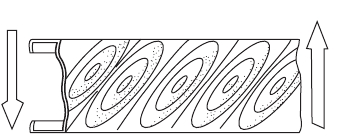
Cold Formed Steel Structures 49-23
Shear in Webs
The primary functions of webs are to keep the flanges apart and to carry the shear loadings. It is necessary
for safe design to ensure that the shear stresses in the webs do not become unacceptably large. In thin
webs there are two potential sources of danger regarding the bahavior of the web in shear. The first is
the possibility of shear stresses, including yield of the material, and the second is the possibility of shear
buckling in the web.
Material Yielding in Shear
With regard to material yielding, the von Mises yield criterion predicts that in the case of a material
under pure shear yielding will occur when the shear stress reaches 0.577 times the yield stress in simple
tension. In AISI with a factor of safety equal to 1.44, shear stresses equal to 0.4 times the yield stress are
allowed at the strength limit state. In the determination of the shear stress limitations with regard to
yield resistance two different provisions are given, one applying to the maximum shear stress in the web
and the other applying to the average shear stress in the web. The average shear stress in the web is
obtained by dividing the shear force by the web area. The use of the average shear stress in design
calculations is simple and expedient, but it should be borne in mind that the shear stress is not normally
constant across the web, and the maximum shear stress should also be checked.
Web Buckling Due to Shear
In short, deep beams with thin webs, as illustrated in Fig. 49.25, local buckling due to shear becomes a
potential problem. Under shear loading the form of the local buckles is rather different from that produced
by direct stresses. The main difference lies in the fact that shear buckles are orientated at some angle to
the axis of the web, as indicated in the figure. The degree of orientation depends on the relative magnitudes
of the direct stresses and shear stresses in the webs, and becomes a maximum of 45° when only shear is
present. This type of buckling has been investigated by many researchers (Rockey, 1967; Allen and Bulson,
1980). After buckling, the web can withstand further loading due to tensile stresses that arise to resist
shear deformation. This resistance is known as tension field action, and for hot-rolled sections tension
field action may be used in design to improve the design capacity.
In the case of cold-formed steel sections the variety of possible sections that must be covered by the
design rules preclude the use of tension field action in the general case in the light of present-day
knowledge, and shear buckling is taken as the limiting factor. However, in view of the underlying sources
of increased safety the reductions in buckling resistance due to imperfections, etc., which are taken into
account for other forms of buckling, are disregarded in the case of web buckling due to shear. In
determining the shear buckling resistance, the worst case of shear on a web is considered.
Combined Effects
When different load actions take place on a member simultaneously, each action affects the general
behavior, and the resistance of a member to one type of load is dependent on the magnitude of all the
load actions on the member. Since in general beams are subjected to shear, bending, and support loading
at the same time, the interactions of each different loading type should be checked out. Ideally in assessing
FIGURE 49.25 Shear buckling of thin web.
V
V
Form of shear buckles
shown by contour lines
© 2003 by CRC Press LLC
